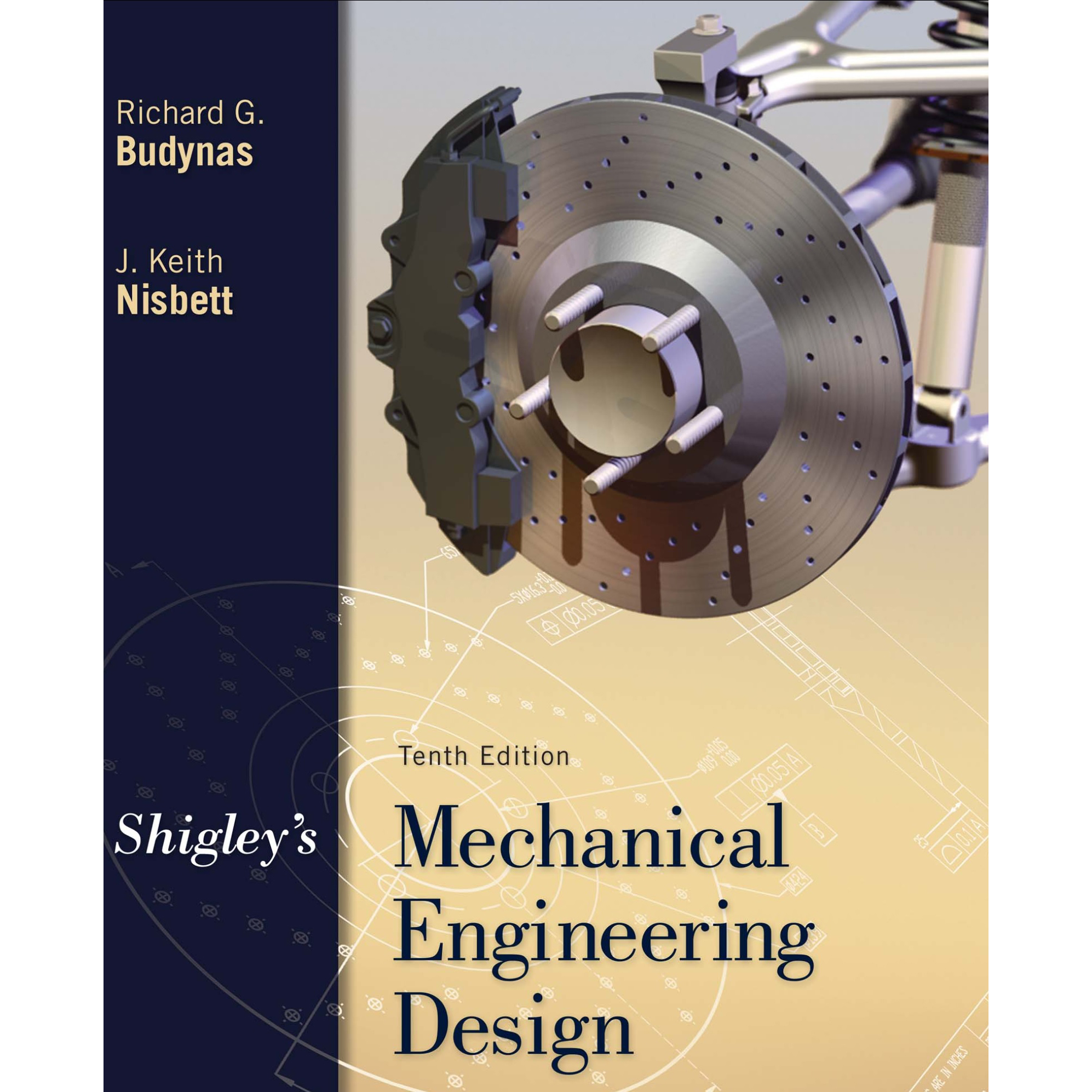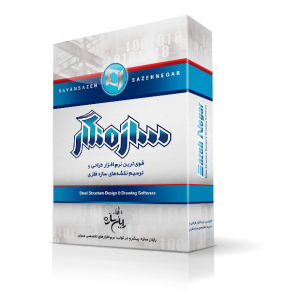توضیحات
کتاب طراحی اجزا به همراه حل المسائل
دانلود کتاب طراحی اجزا شیگلی ویرایش 10 به همراه حل المسائل
دانلود کتاب و حل المسائل طراحی اجزای مکانیکی شیگلی ویرایش دهم (سال 2014). Shigley’s Mechanical Engineering Design 10th edition by Budynas
کتاب طراحی اجزا ماشین شیگلی درباره انواع و اقسام اتصالات دائم (مانند جوش و لحیم و چسب) و موقت (مانند پیچ و مهره و گوه) و همچنین تخمین عمر قطعه و طراحی قطعه برای عمر معین با استفاده از اطلاعات مکانیک شکست بحث شده است. به علاوه درباره درباره شفت ها و ترک ها (شکست) نیز مطالبی به میان آمده.
فهرست
فصل 1 : مقدمه ای بر طراحی اجزای ماشین
فصل 2 : مواد و متریال
فصل 3 : آنالیز تنش و بار
فصل 4 : استحکام و شکست
فصل 5 : آنالیز شکست بر اثر بارهای استاتیکی
فصل 6 : آنالیز خستگی و شکست بر اثر بارگذاری متغیر
فصل 7 : شافت و طراحی اجزای شافت
فصل 8 : پیچها، اتصالات و طراحی اتصالات غیرثابت
فصل 9 : جوشکاری، قید و بندها و طراحی اتصالات ثابت
فصل 10 : ارتجاعات مکانیکی – فنرها
فصل 11 : رولربیرینگ ها – یاتاقان های تماس
فصل 12 : روانکاری و یاتاقان های ژورنال
فصل 13 : چرخدنده ها
فصل 14 : چرخ دنده های ساده و حلزونی
فصل 15 : چرخ دنده های مارپیچی و مخروطی
فصل 16 : کلاچ، تکلمه عبور، کوپلینگ و فلایویل
فصل 17 : تجهیزات مکانیکی قابل انعطاف
فصل 18 : مطالعه انتقال توان
فصل 19 : آنالیز المان محدود
فصل 20 : ملاحظات آماری
Joseph Edward Shigley (1909–1994) is undoubtedly one of the most well-known
and respected contributors in machine design education. He authored or coauthored
eight books, including Theory of Machines and Mechanisms (with John J. Uicker, Jr.),
and Applied Mechanics of Materials. He was coeditor-in-chief of the well-known
Standard Handbook of Machine Design. He began Machine Design as sole author in
1956, and it evolved into Mechanical Engineering Design, setting the model for such
textbooks. He contributed to the first five editions of this text, along with coauthors
Larry Mitchell and Charles Mischke. Uncounted numbers of students across the world
got their first taste of machine design with Shigley’s textbook, which has literally
become a classic. Nearly every mechanical engineer for the past half century has
referenced terminology, equations, or procedures as being from “Shigley.” McGraw-Hill
is honored to have worked with Professor Shigley for more than 40 years, and as a
tribute to his lasting contribution to this textbook, its title officially reflects what many
have already come to call it—Shigley’s Mechanical Engineering Design.
Having received a bachelor’s degree in Electrical and Mechanical Engineering
from Purdue University and a master of science in Engineering Mechanics from the
University of Michigan, Professor Shigley pursued an academic career at Clemson
College from 1936 through 1954. This led to his position as professor and head of
Mechanical Design and Drawing at Clemson College. He joined the faculty of the
Department of Mechanical Engineering of the University of Michigan in 1956, where
he remained for 22 years until his retirement in 1978.
Professor Shigley was granted the rank of Fellow of the American Society of
Mechanical Engineers in 1968. He received the ASME Mechanisms Committee
Award in 1974, the Worcester Reed Warner Medal for outstanding contribution to
the permanent literature of engineering in 1977, and the ASME Machine Design
Award in 1985.
Joseph Edward Shigley indeed made a difference. His legacy shall continue
Mechanical design is a complex process, requiring many skills. Extensive relationships need to be subdivided into a series of simple tasks. The complexity of the
process requires a sequence in which ideas are introduced and iterated.
We first address the nature of design in general, and then mechanical engineering
design in particular. Design is an iterative process with many interactive phases. Many
resources exist to support the designer, including many sources of information and an
abundance of computational design tools. Design engineers need not only develop
competence in their field but they must also cultivate a strong sense of responsibility
and professional work ethic.
There are roles to be played by codes and standards, ever-present economics,
safety, and considerations of product liability. The survival of a mechanical component is often related through stress and strength. Matters of uncertainty are everpresent in engineering design and are typically addressed by the design factor and
factor of safety, either in the form of a deterministic (absolute) or statistical sense.
The latter, statistical approach, deals with a design’s reliability and requires good
statistical data.
In mechanical design, other considerations include dimensions and tolerances,
units, and calculations.
This book consists of four parts. Part 1, Basics, begins by explaining some differences between design and analysis and introducing some fundamental notions and
approaches to design. It continues with three chapters reviewing material properties,
stress analysis, and stiffness and deflection analysis, which are the principles necessary for the remainder of the book.
Part 2, Failure Prevention, consists of two chapters on the prevention of failure
of mechanical parts. Why machine parts fail and how they can be designed to prevent
failure are difficult questions, and so we take two chapters to answer them, one on
preventing failure due to static loads, and the other on preventing fatigue failure due
to time-varying, cyclic loads.
In Part 3, Design of Mechanical Elements, the concepts of Parts 1 and 2 are
applied to the analysis, selection, and design of specific mechanical elements such as
shafts, fasteners, weldments, springs, rolling contact bearings, film bearings, gears,
belts, chains, and wire ropes.
Part 4, Special Topics, provides introductions to two important methods used in
mechanical design, finite element analysis and geometric dimensioning and tolerancing. This is optional study material, but some sections and examples in Parts 1 to 3
demonstrate the use of these tools.
There are two appendixes at the end of the book. Appendix A contains many
useful tables referenced throughout the book. Appendix B contains answers to selected
end-of-chapter problems
Design
To design is either to formulate a plan for the satisfaction of a specified need or to
solve a specific problem. If the plan results in the creation of something having a
physical reality, then the product must be functional, safe, reliable, competitive,
usable, manufacturable, and marketable.
Design is an innovative and highly iterative process. It is also a decision-making
process. Decisions sometimes have to be made with too little information, occasionally
with just the right amount of information, or with an excess of partially contradictory
information. Decisions are sometimes made tentatively, with the right reserved to
adjust as more becomes known. The point is that the engineering designer has to be
personally comfortable with a decision-making, problem-solving role.
Design is a communication-intensive activity in which both words and pictures
are used, and written and oral forms are employed. Engineers have to communicate
effectively and work with people of many disciplines. These are important skills, and
an engineer’s success depends on them.
A designer’s personal resources of creativeness, communicative ability, and problemsolving skill are intertwined with the knowledge of technology and first principles.
Engineering tools (such as mathematics, statistics, computers, graphics, and languages)
are combined to produce a plan that, when carried out, produces a product that is
functional, safe, reliable, competitive, usable, manufacturable, and marketable, regardless of who builds it or who uses it
Mechanical Engineering Design
Mechanical engineers are associated with the production and processing of energy
and with providing the means of production, the tools of transportation, and the
techniques of automation. The skill and knowledge base are extensive. Among the
disciplinary bases are mechanics of solids and fluids, mass and momentum transport,
manufacturing processes, and electrical and information theory. Mechanical engineering
design involves all the disciplines of mechanical engineering.
Real problems resist compartmentalization. A simple journal bearing involves
fluid flow, heat transfer, friction, energy transport, material selection, thermomechanical treatments, statistical descriptions, and so on. A building is environmentally controlled. The heating, ventilation, and air-conditioning considerations are sufficiently
specialized that some speak of heating, ventilating, and air-conditioning design as if
it is separate and distinct from mechanical engineering design. Similarly, internalcombustion engine design, turbomachinery design, and jet-engine design are sometimes considered discrete entities. Here, the leading string of words preceding the
word design is merely a product descriptor. Similarly, there are phrases such as
machine design, machine-element design, machine-component design, systems design,
and fluid-power design. All of these phrases are somewhat more focused examples of
mechanical engineering design. They all draw on the same bodies of knowledge, are
similarly organized, and require similar skills
Phases and Interactions of the Design Process
What is the design process? How does it begin? Does the engineer simply sit down
at a desk with a blank sheet of paper and jot down some ideas? What happens next?
What factors influence or control the decisions that have to be made? Finally, how
does the design process end?
The complete design process, from start to finish, is often outlined as in Fig. 1–1.
The process begins with an identification of a need and a decision to do something
about it. After many iterations, the process ends with the presentation of the plans
for satisfying the need. Depending on the nature of the design task, several design
phases may be repeated throughout the life of the product, from inception to termination. In the next several subsections, we shall examine these steps in the design
process in detail.
Identification of need generally starts the design process. Recognition of the need
and phrasing the need often constitute a highly creative act, because the need may be
only a vague discontent, a feeling of uneasiness, or a sensing that something is not
right. The need is often not evident at all; recognition can be triggered by a particular
adverse circumstance or a set of random circumstances that arises almost simultaneously. For example, the need to do something about a food-packaging machine may
be indicated by the noise level, by a variation in package weight, and by slight but
perceptible variations in the quality of the packaging or wrap.
There is a distinct difference between the statement of the need and the definition
of the problem. The definition of problem is more specific and must include all the
specifications for the object that is to be designed. The specifications are the input
and output quantities, the characteristics and dimensions of the space the object must
occupy, and all the limitations on these quantities. We can regard the object to be
designed as something in a black box. In this case we must specify the inputs and
outputs of the box, together with their characteristics and limitations. The specifications define the cost, the number to be manufactured, the expected life, the range, the
operating temperature, and the reliability. Specified characteristics can include the speeds,
feeds, temperature limitations, maximum range, expected variations in the variables,
dimensional and weight limitations, etc.
There are many implied specifications that result either from the designer’s particular environment or from the nature of the problem itself. The manufacturing processes that are available, together with the facilities of a certain plant, constitute
restrictions on a designer’s freedom, and hence are a part of the implied specifications.
It may be that a small plant, for instance, does not own cold-working machinery.
Knowing this, the designer might select other metal-processing methods that can be
performed in the plant. The labor skills available and the competitive situation also
constitute implied constraints. Anything that limits the designer’s freedom of choice
is a constraint. Many materials and sizes are listed in supplier’s catalogs, for instance,
but these are not all easily available and shortages frequently occur. Furthermore,
inventory economics requires that a manufacturer stock a minimum number of materials and sizes. An example of a specification is given in Sec. 1–18. This example is
for a case study of a power transmission that is presented throughout this text.
The synthesis of a scheme connecting possible system elements is sometimes
called the invention of the concept or concept design. This is the first and most important
step in the synthesis task. Various schemes must be proposed, investigated, and quantified in terms of established metrics.1 As the fleshing out of the scheme progresses,
analyses must be performed to assess whether the system performance is satisfactory
or better, and, if satisfactory, just how well it will perform. System schemes that do
not survive analysis are revised, improved, or discarded. Those with potential are
optimized to determine the best performance of which the scheme is capable. Competing
schemes are compared so that the path leading to the most competitive product can
be chosen. Figure 1–1 shows that synthesis and analysis and optimization are intimately
and iteratively related.
We have noted, and we emphasize, that design is an iterative process in which
we proceed through several steps, evaluate the results, and then return to an earlier
phase of the procedure. Thus, we may synthesize several components of a system,
analyze and optimize them, and return to synthesis to see what effect this has on the
remaining parts of the system. For example, the design of a system to transmit power
requires attention to the design and selection of individual components (e.g., gears,
bearings, shaft). However, as is often the case in design, these components are not
independent. In order to design the shaft for stress and deflection, it is necessary to
know the applied forces. If the forces are transmitted through gears, it is necessary
to know the gear specifications in order to determine the forces that will be transmitted to the shaft. But stock gears come with certain bore sizes, requiring knowledge
of the necessary shaft diameter. Clearly, rough estimates will need to be made in order
to proceed through the process, refining and iterating until a final design is obtained
that is satisfactory for each individual component as well as for the overall design
specifications. Throughout the text we will elaborate on this process for the case study
of a power transmission design.
Both analysis and optimization require that we construct or devise abstract models of the system that will admit some form of mathematical analysis. We call these
models mathematical models. In creating them it is our hope that we can find one
that will simulate the real physical system very well. As indicated in Fig. 1–1, evaluation is a significant phase of the total design process. Evaluation is the final proof
of a successful design and usually involves the testing of a prototype in the laboratory.
Here we wish to discover if the design really satisfies the needs. Is it reliable? Will
it compete successfully with similar products? Is it economical to manufacture and to
use? Is it easily maintained and adjusted? Can a profit be made from its sale or use?
How likely is it to result in product-liability lawsuits? And is insurance easily and
cheaply obtained? Is it likely that recalls will be needed to replace defective parts or
systems? The project designer or design team will need to address a myriad of engineering and non-engineering questions.
Communicating the design to others is the final, vital presentation step in the
design process. Undoubtedly, many great designs, inventions, and creative works have
been lost to posterity simply because the originators were unable or unwilling to
properly explain their accomplishments to others. Presentation is a selling job. The
engineer, when presenting a new solution to administrative, management, or supervisory persons, is attempting to sell or to prove to them that their solution is a better
one. Unless this can be done successfully, the time and effort spent on obtaining the
solution have been largely wasted. When designers sell a new idea, they also sell
themselves. If they are repeatedly successful in selling ideas, designs, and new solutions to management, they begin to receive salary increases and promotions; in fact,
this is how anyone succeeds in his or her profession
| Part 1 1 | Basics 2 Introduction to Mechanical Engineering Design 3 |
2 Materials 41
3 Load and Stress Analysis 85
4 Deflection and Stiffness 161
| Part 2 5 | Failure Prevention 226 Failures Resulting from Static Loading 227 |
6 Fatigue Failure Resulting from Variable Loading 273
Part 3 Design of Mechanical Elements 350
7 Shafts and Shaft Components 351
8 Screws, Fasteners, and the Design
of Nonpermanent Joints 401
9 Welding, Bonding, and the Design
of Permanent Joints 467
10 Mechanical Springs 509
11 Rolling-Contact Bearings 561
12 Lubrication and Journal Bearings 609
13 Gears—General 665
14 Spur and Helical Gears 725
15 Bevel and Worm Gears 777
16 Clutches, Brakes, Couplings, and Flywheels 817
17 Flexible Mechanical Elements 871
18 Power Transmission Case Study 925
Part 4 Special Topics 944
19 Finite-Element Analysis 945
20 Geometric Dimensioning and Tolerancing 969
Appendixes
A Useful Tables 1011
B Answers to Selected Problems 1067
Shigley’s Mechanical Engineering Design is intended for students beginning the study of mechanical engineering design. Students will find that the text inherently directs them into familiarity with both the basics of design decisions and the standards of industrial components. It combines the straightforward focus on fundamentals that instructors have come to expect with a modern emphasis on design and new applications. This edition maintains the well-designed approach that has made this book the standard in machine design for nearly 50 years.McGraw-Hill Education’s Connect is also available as an optional add on item. Connect is the only integrated learning system that empowers students by continuously adapting to deliver precisely what they need when they need it how they need it so that class time is more effective. Connect allows the professor to assign homework quizzes and tests easily and automatically grades and records the scores of the student’s work. Problems are randomized to prevent sharing of answers an may also have a “multi-step solution” which helps move the students’ learning along if they experience difficulty.
TABLE OF CONTENTS
Part 1 – Basics
1) Introduction to Mechanical Engineering Design
2) Materials
3) Load and Stress Analysis
4) Deflection and Stiffness
Part II – Failure Prevention
5) Failures Resulting from Static Loading
6) Fatigue Failure Resulting from Variable Loading
Part III – Design of Mechanical Elements
7) Shafts and Shaft Components
8) Screws, Fasteners, and the Design of Nonpermanent Joints
9) Welding, Bonding, and the Design of Permanent Joints
10) Mechanical Springs
11) Rolling-Contact Bearings
12) Lubrication and Journal Bearings
13) Gears – General
14) Spur and Helical Gears
15) Bevel and Worm Gears
16) Clutches, Brakes, Couplings and Flywheels
17) Flexible Mechanical Elements
18) Power Transmission Case Study
Part IV – Special Topics
19) Finite Element Analysis
20) Geometric Dimensioning and Tolerancing
Appendices
A – Useful Tables
B – Answers to Selected Problems








نقد و بررسیها
هیچ دیدگاهی برای این محصول نوشته نشده است.